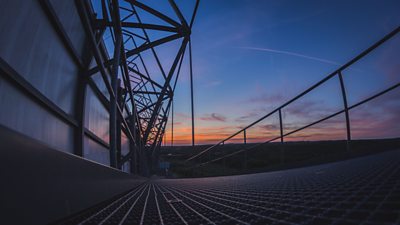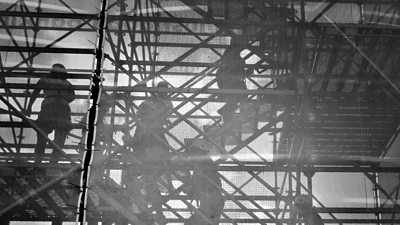Whilst they come in a range of shapes and sizes, they basically all do the same thing – lift people up to 60+m into the air within a protected cage or platform. They have many uses in filming but the main ones are to get high level wide shots, views over obstructions, access to objects high up or provide high level lighting.
What Can Go Wrong?
- Fall from height – due to over-turning, over-balancing, over-loading, sudden jolts, tipping of platform due to hydraulic failure or operator error.
- Struck by falling objects – items dropped from cage when aloft
- Anxiety / panic attack – caused by fear of heights, especially when stuck aloft or when swaying in wind
- Trapping / crush injury – due to striking objects when positioning platform
- Electrocution – due to striking power lines or lightning strike
- Welfare / fatigue – due to exposure to weather / sun, lack of access to rest facilities.
Legal/Â鶹Éç Requirements
- Ensure work at height is properly planned and organised.
- Ensure risks from work at height are assessed and appropriate work equipment is selected.
- Ensure equipment used for work at height is properly inspected and maintained - check MEWP has a safety inspection certificate issued within previous 6 months.
- Check MEWP operator is competent i.e. holds the appropriate ‘IPAF licence’.
- Use a Â鶹Éç pre-vetted contractor to provide and operate your MEWP as a ‘wet hire’
Control Measures
Planning your work at height
- Decide whether a MEWP is the most suitable means of access for the job - if lifting any production equipment, discuss this with the MEWP supplier (see 'Lifting Equipment with MEWPs' in Useful Documents)
- In the UK, you should hire your MEWP from the list of pre-vetted suppliers for hoists / hydraulic platforms. Any departure from this must be discussed with your Safety Advisor
- If working close to overhead structures is going to be required (e.g. studio grid), mininmise the over-run crushing risk by hiring the correct size of MEWP and consider need for one with some form of secondary guarding i.e. pressure pad isolators or proximity sensors (see Avoiding Crushing / Trapping Injuries in Useful Documents)
- When working overseas, you will need to vet the MEWP supplier and arrange contract terms yourself
- Be prepared for the MEWP operator needing to recce the location to see any access constraints
- Ensure that those required to work in the MEWP are happy to do so i.e. they don’t have a fear of heights.
Documentation
- Obtain a lifting plan / risk assessment from the MEWP operator - they are responsible for its safety, so you need to comply with their instructions. Review their plan / assessment to ensure it meets your requirements and addresses your, and the venue’s, safety concerns – be wary of generics. The plan must cover rescue procedures in case of failure of the hydraulic system.
- Check the operator has an appropriate and in-date qualification i.e. holds an IPAF powered access licence for the class of MEWP to be used.
- Check the MEWP has an up to date (i.e. within the last 6 months) LOLER safety inspection certificate.
- If overseas and the documents listed above are not available, you must check the age and obvious visual condition of the MEWP (see it operated first), check what maintenance records they have for it and seek what verbal safety assurances you can get from local independent sources (e.g. your fixer).
- Ensure use of the MEWP is included in your programme risk assessment form – for those going aloft, agree sensible working hours to allow rest / meal breaks and ensure they will be appropriately clothed and protected from the elements.
MEWP use on location
- Keep the MEWP operator’s risk assessment on location and check it is being complied with. Ensure all certificates are in place and in date.
- For cherry pickers with tilting platforms, all in the cage must wear a suitable harness, lanyard and climbing-type helmet. A work restraint set up is the advised means of protection (see our Safety Short in Useful Documents). A harness need not be worn in a scissor lift (i.e. one which does not tilt)
- No loose items to be carried or stored in the cage. Any rigged equipment (e.g. lights, cameras) must be safety bonded to the cage rail as a second means of attachment
- Ensure that the MEWP operator is aware of what it is you want to lift - have weights of heavy equipment to hand. Make sure the safe working load of the platform is not exceeded.
- For any 'unconventional lifts', for example, where the platform is unevenly loaded with heavy items, or the items lifted greatly increases the wind loading on the MEWP, such as large drapes or reflectors, please see our 'Lifting equipment with MEWPs' in Useful Documents
- For very large MEWPs, ensure there is a means of communication (e.g. walkie-talkie) between the ground and those aloft
- Maintain a suitably large exclusion zone around the base of the MEWP
- Ensure cables are secured at cage level and are managed at ground level to prevent snagging or hitting others when the platform is moved.
Division Specific Issues
- No division specific issues.
FAQs/Did You Know?
- All MEWP contractors on our pre-vetted list have signed our terms of trade which specifically make them responsible for arranging safe access of the MEWP (termed a ‘contract lift’).
- Contracting operators independently or signing the contractor’s terms of trade (carefully check your invoice wording) could make you liable for its safe access and any problems arising out of this.
- Except where there are two operators, it is normal for the operator to control the platform’s position from the ground, where they can more easily override any controls and effect a ‘bleed down’ rescue.
- For scissor lifts (which don’t tip and only go up and down), provided they have adequate edge protection, a safety harness need not be worn.
- The HSE's information sheet (October 2014) is aimed at people who select, specify, manage and operate MEWPs. It tells you what to consider before selecting a MEWP and the risks to be assessed and managed while it's in use.
Useful documents
-
[Â鶹Éç Network only]
-
[Â鶹Éç network only]
Recommended links
-
[Gateway]
-
-
-
Working at Height topics
-

General
Guidance to assist planning, conducting or managing staff who are working at height -

Gantries & High Level Platforms
Guidance on media positions within stadiums and arenas -

Ladders
Guidance on ladders to work up to approx. 6m high -

Ladder Pods
Guidance on ladder pods to work up to 5m high -

Mobile Elevating Work Platforms
Guidance on mobile elevating work platforms (MEWP) such as cherry pickers and scissor lifts. -

Rope Access Techniques
The equipment and techniques required to protect those working at or near exposed drops. -

Ropes Riggers: Selection of
Competence criteria for the various professional Ropes Riggers. -

Tower Scaffolds
Guidance on tower scaffolds to work up to approx 8m high
More from SSR
-
Your platform to record accidents, risk assessments, assurance monitoring and inspections
-
Safety Equipment Stores
Just one number to call: 020 3614 5155 -
Â鶹Éç Safety Guidelines
An A-Z of Â鶹Éç's Health and Safety Guidelines -
Safety Advice Line: 0370 411 0464 Email: safety@bbc.co.uk
- A-Z of Â鶹Éç Safety Guidelines
- Accident Reporting and Investigation
- Â鶹Éç Health & Safety Policy
- Contractors (incl. vetted lists)
- Contributors
- Fire Safety
- Freelancers
- Independent Production Companies
- Risk Assessment
- Safety Alerts
- Safety Responsibilities
- Safety Training
- Sets & Premises Safety Guide
Events guidance - key links:
- Exhibitions
- General Guidance
- Indoor Location Recce Checklist
- Outdoor Location Recce Checklist
- Major Incidents & Emergency Planning
- Marketing and Promotional
- Noise Exposure
- Planning and Management
- Responsibilities
- Responsibilities Form
- Laser Lighting Effects
- Strobe Lighting
- Temporary Stages and Rostra
Health topics - key links:
- (Â鶹Éç network only)
- Contributors Fitness to Participate
- Display Screen Equipment (DSE)
- (Â鶹Éç network only)
- First Aid and Welfare on Location
- International Travel - Risks & Health
- Manual Handling
- Mental Health: Homepage
- (Â鶹Éç network only)
- Personal Health and Wellbeing
- Pregnancy
- Psychological Trauma Support & Trauma Risk Management (TRiM)
- Tiredness and Fatigue
- Travel Health Contacts
Â鶹Éç High Risk - key links:
- CBRN and Industrial Spills
- Covert Filming
- Crisis Management and Security Support
- Demonstrations, Protests and Crowds
- Disaster Coverage
- Door Stepping
- (Â鶹Éç network only)
- (Â鶹Éç network only)
- Public Order
- Safety Equipment Stores
Â鶹Éç Journalism - key links:
Â鶹Éç Productions - key links:
- Aerial Filming and Airfields
- Animals: Displaying and handling for performance
- Boats: Working on
- Children and Young People
- Driving
- Electrical Equipment and Systems
- First Aid and Welfare on Location
- Food Safety (Cooking and Catering)
- Remote Location Working
- Roads and Streets: Working by
- Security of Productions on Location
- Stunts
- Tiredness and Fatigue
- Unmanned Aerial Systems (UAS aka Drones)
- Vehicles: Recording in, from and around
- Working at Height: Mobile Elevating Work Platforms
- Working at Height: Tower Scaffolds
Â鶹Éç Radio - key links:
- (Â鶹Éç Network only)
Â鶹Éç Security - key links:
Â鶹Éç Sport - key links:
About this site
This site describes what the Â鶹Éç does in relation to managing its health, safety and security risks and is intended for those who work directly for the Â鶹Éç.
It is not intended to provide instruction or guidance on how third parties should manage their risks. The Â鶹Éç cannot be held liable for how this information is interpreted or used by third parties, nor provide any assurance that adopting it would provide any measure of legal compliance. More information
Some links on this site are only accessible when connected to the Â鶹Éç network

